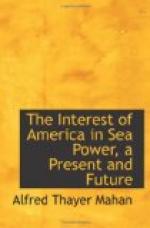Every possible site for an interoceanic canal lies within the strip of land thus visited by Columbus shortly before his death in 1504. How narrow the insurmountable obstacle, and how tantalizing, in the apparent facilities for piercing it extended by the formation of the land, were not known until ten years later, when Balboa, led on by the reports of the natives, reached the eminence whence he, first among Europeans, saw the South Sea,—a name long and vaguely applied to the Pacific, because of the direction in which it lay from its discoverer. During these early years the history of the region we now know as Central America was one of constant strife among the various Spanish leaders, encouraged rather than stifled by the jealous home government; but it was also one of unbroken and venturesome exploration, a healthier manifestation of the same restless and daring energy that provoked their internal collisions. In January, 1522, one Gil Gonzalez started from Panama northward on the Pacific side, with a few frail barks, and in March discovered Lake Nicaragua, which has its name from the cacique, Nicaragua, or Nicarao, whose town stood upon its shores. Five years later, another adventurer took his vessel to pieces on the coast, transported it thus to the lake, and made the circuit of the latter; discovering its outlet, the San Juan, just a quarter of a century after Columbus had visited the mouth of the river.
The conquest of Peru, and the gradual extension of Spanish domination and settlements in Central America and along the shores of the Pacific, soon bestowed upon the Isthmus an importance, vividly suggestive of its rise into political prominence consequent upon the acquisition of California by the United States, and upon the spread of the latter along the Pacific coast. The length and severity of the voyage round Cape Horn, then as now, impelled men to desire some shorter and less arduous route; and, inconvenient as the land transport with its repeated lading and unlading was, it presented before the days of steam the better alternative, as to some extent it still does. So the Isthmus and its adjoining regions became a great centre of commerce, a point where many highways converged and whence they parted; where the East and the West met in intercourse, sometimes friendly, more often hostile. Thus was realized partially, though most incompletely, the vision of Columbus; and thus, after many fluctuations, and despite the immense expansion of these latter days, partial and incomplete his great conception yet remains. The secret of the strait is still the problem and the reproach of mankind.




